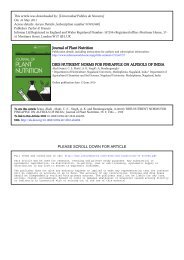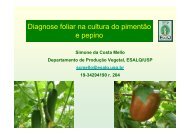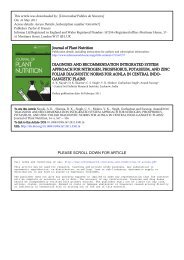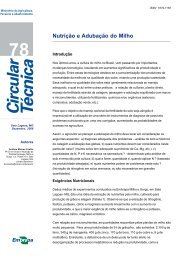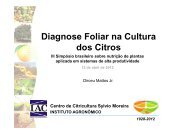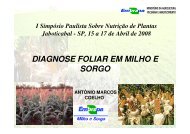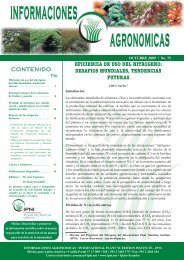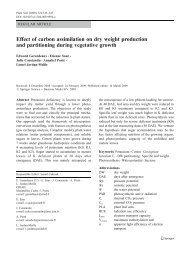166 Plant Soil (2008) 304:157–168Table 4 Relative (K0/K+) growth (leaves, axile and lateral roots) and physiological (RUE, water content, sugar content) responses toK <strong>de</strong>ficiency, towards thermal time, stage and K concentration in starved plantsThermal Visible [K] intime afterstarvationleafstagePlantDM K0[K] in plant waterLeafElongationRateRoot Elongation Rate RUE Water contentSoluble sugars˚C days g.g -1 1 0.9 0.7 0.5 0.3 0.1 1 0.9 0.8 0.7 1.2 1.1 1 0.9 0.8 0.7 0.6 0.5 0.4 1 0.9 0.8 0.7 1 0.99 0.98 0.97 0.96 0.95 1.6 1.5 1.4 1.3 1.2 1.1 1 0.9 0.8 0.730 5,0 0.04 + + + +60 5.9 0.034 + + + +90 6.8 0.018 + + . + +120 7.8 0.015 + + . + +150 8.7 0.011 + + . + +180 9.6 0.009 + + . +leaves+ axile roots. lateral roots+ leaves + axile rootsMain gross tendanciesvalues of K0/values of K+) for most of thesevariables. On the whole, the plant response patternduring the initial period (mo<strong>de</strong>rate K <strong>de</strong>ficiency) maybe interpreted as the consequence of an initial effectof K <strong>de</strong>ficiency on the ability of leaf growing zone toexpand correctly. Conversely, photosynthetic processesdon't seem to be affected. According to Lockart(1965), cell growth is controlled by turgor pressureand cell wall extensibility. Potassium is involved inthe control of both processes, so that the observedreduced leaf elongation may be the consequence ofaltered cell-wall properties, osmotic and turgor pressures(Triboulot et al. 1997). These unfavourablebiophysical conditions are not likely to affect the rootcompartment, especially in our hydroponic conditions(Sharp et al. 1988, 1990), whereas roots are likely toget more carbohydrates from shoots since theirutilisation in aerial parts is limited by the reducedleaf growth. This latter interpretation is supported byfour observations (1) root elongation was stimulatedbetween 45 and 75 <strong>de</strong>gree-days, whereas leaf elongationwas reduced, (2) this stimulation was associatedwith an increased soluble sugar content. Thishigher sugar content may contribute to osmoticpotential and provi<strong>de</strong> carbon for growth, (3) in ourexperimental conditions (low inci<strong>de</strong>nt PAR) rootgrowth was likely to be limited by C, which isconfirmed by the existence of correlations betweenRER and inci<strong>de</strong>nt PAR, (4) the RUE was not affectedby K treatments during the first part of the experiment,which suggests that net carbon assimilation perunit leaf area was not reduced, but its allocationbetween shoots and roots was altered, as confirmedby the root biomass/plant biomass ratio. This “unfavourablebiophysical conditions” hypothesis and itsassociated effects on carbon allocation, which seemssufficient to account for the plant response during thefirst part of the experiment, however failed to explainwhat happened during the second part of theexperiment. The root elongation was reduced, bothon axile roots and to a greater extent on first-or<strong>de</strong>rlateral roots, and the RUE was severely reduced,which suggests that net carbon assimilation per unitleaf area was affected. Other physiological processesare likely to be affected, possibly due to thebiochemical functions of K.Theoritical K concentration in cell compartments (mM)120100806040200[K]vacuole[K]cytoplasmRelative DM0 10 20 30 40 50 601.21.00.80.60.40.20.0K content in dry matter (mg . kg -1 )Fig. 8 Relative dry matter yield (DM K0/DM K+) andcalculated concentrations of K in the cytoplasm and vacuoleas a function of K content in the dry matter (mg kg −1 ). Figureadapted from Leigh and Wyn Jones 1984, with the assumptionsthat [K] cyt =101 mM, [K] min vac =19 mM and that the proportionof intracellular volume occupied by the cytoplasm is 10%Dry matter K0 / K+
Plant Soil (2008) 304:157–168 167This general pattern of response is in agreementwith the mo<strong>de</strong>l of Leigh and Wyn Jones, suggestingthat biophysical functions, and therefore growth ratesof organs, are likely to be affected first in the event ofK <strong>de</strong>ficiency. Moreover, it is worth noting that in ourexperiment the value of maize dry weight in relationto its K concentration followed the same trend as thatreported by Leigh and Wyn Jones (1984) (Fig. 8). Theexpected concentrations in the vacuolar and cytoplasmiccompartments were therefore calculated on thebasis of Leigh and Wyn Jones' theoretical relationship,with the following assumptions: the proportionof intracellular volume occupied by the cytoplasmis 10%, the minimum level of K in the vacuoles is19 mM and the initial value of K in the cytoplasm is101 mM. This calculation suggests that the K contentin the cytoplasmic compartment began to drop for Kconcentrations in dry matter below 15 g kg −1(35 mM). According to the Leigh and Wyn Jonesmo<strong>de</strong>l, effects of K <strong>de</strong>privation on K biochemicalfunctions were thus expected below this thresholdvalue. Consistently the “unfavourable biophysicalconditions” hypothesis and its associated effects oncarbon allocation failed to explain the plant responseduring the second half of the experiment (three lastsampling dates), when the RUE was severely reducedfor K0 plants. This roughly corresponds to the periodfor which the K concentration dropped below 35 mM(Fig. 1), as expressed on a tissue water basis.Acknowledgements Thanks are due to S. Thunot and S.Milin for their technical assistance.ReferencesArkebauer TJ, Norman JM (1995) From cell growth to leafgrowth: II; Simulation of a file of cells. Agron J 87:106–112Barraclough PB, Leigh RA (1993) Grass yield in relation topotassium supply and the concentration of cations in tissuewater. J Agric Sci 121:157–168Bednarz CW, Oosterhuis DM (1999) Physiological changesassociated with potassium <strong>de</strong>ficiency in cotton. J PlantNutr 22:303–313Ben-Haj-Salah H, Tardieu F (1995) Temperature affectsexpansion rate of maize leaves without change in spatialdistribution of cell length. Analysis of the coordinationbetween cell division and cell expansion. Plant Physiol109:861–870Bonhomme R, Ruget F, Derieux M, Vincourt P (1982)Relations entre production <strong>de</strong> matière sèche et énergieinterceptée chez différents génotypes <strong>de</strong> maïs. C R AcadSci Paris Sér III 294:393–398Cakmak I, Hengeler C, Marschner H (1994) Partitioning ofshoot and root dry matter and carbohydrates in bean plantssuffering from phosphorus, potassium and magnesium<strong>de</strong>ficiency. J Exp Bot 45:1245–1250Caporn SJM, Ludwigand LJ, Flowers TJ (1982) Potassium<strong>de</strong>ficiency and photosynthesis in tomato. In Plant NutritionProc. of the 9th Congr. Int. Potash Inst. pp 95–111Carroll MJ, Slaughter LH, Krouse JM (1994) Turgor potentialand osmotic constituents of Kentucky bluegrass leavessupplied with four levels of potassium. Agron J 86:1079–1083Chartier M, Bonchretien P, Allirand JM, Gosse G (1989)Utilisation <strong>de</strong>s cellules au silicium amorphe pour lamesure du rayonnement photosynthétiquement actif(400–700 nm). Agronomie 9:281–284Durand JL, Gautier H, Castell JF, Drouet JL (1995) Eau,carbone, azote et zones <strong>de</strong> croissance. In Actes <strong>de</strong> l'Ecole-Chercheurs INRA. Tome 1: De la plante au couvertvégétal. Eds. P Cruizat and JP Lagouar<strong>de</strong>. pp 197–216.INRA, Département Bioclimatologie, ParisEl Dessougi H, Classen N, Steingrobe B (2002) Potassiumefficiency mechanisms of wheat, barley and sugar beetgrown on a K fixing soil un<strong>de</strong>r controlled conditions. JPlant Nutr Soil Sci 165:732–737Ericson T (1995) Growth and shoot:root ratio of seedlings inrelation to nutrient availability. Plant Soil 168–169:205–214Evans HJ, Wil<strong>de</strong>s RA (1971) Potassium and its role in enzymeactivation. Proceedings of the 8th Colloquium of theInternational Potash Institute. Berne. Switzerland: InternationalPotash Institute. P.1V39Henning HJ (2003) The effects of potassium <strong>de</strong>ficiency ongrowth and N 2 -fixation in Trifolium repens. Physiol Plant1129:440–449Hsiao TC, Laüchli A (1986) Role of potassium in plant-waterrelations. In: Tinker B, Läuchli A (eds) Advances in plantnutrition, Vol. II. Praeger, New York, pp 281–311Huber SC (1984) Biochemical basis for effects of K-<strong>de</strong>ficiencyon assimilate export rate and accumulation of solublesugars in soybean leaves. Plant Physiol 76:424–430Huber SC (1985) Role of potassium in photosynthesis andrespiration. In: Munson RD (ed) Potassium in agriculture.ASA-CSSA-SSSA, Madison, WI 53711, USA, pp 369–396Itoh R, Yamagishi J, Ishii R (1997) Effects of potassium<strong>de</strong>ficiency on leaf growth, related water relations andaccumulation of solutes in leaves of soybean plants. Jpn JCrop Sci 66:691–697Jordan-Meille L, Pellerin S (2004) Shoot and root growth of anhydroponic grown maize (Zea mays L.) as influenced by K<strong>de</strong>ficiency. Plant Soil 265:75–92Koch DW, Estes GO (1975) Influence of potassium stress ongrowth, stomatal behaviour and CO 2 assimilation in corn.Crop Sci 15:397–699Kunst A, Draeger B, Ziegenhorn J (1984) D-Glucose/Dfructose.In: Bergmeyer HU (ed) Methods of enzymaticanalysis. 3rd edn. Verlag Chemie, Weinheim, Germany,pp 178–185Leigh RA (1989) Potassium concentrations in whole plants andcells in relation to growth. Proc. 21st Coll. Int. PotashInst., Bern. pp 117–126



